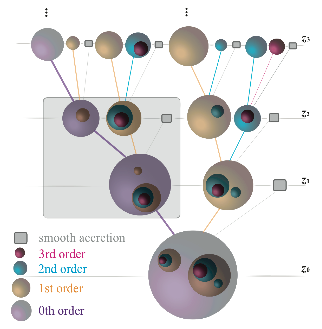Research

Before I came to Yale, I worked with Prof. Zongyun Li on cataclysmic variable stars, at Nanjing University, China. The “super-humps” in the light curves of the cataclysmic variables provides insight of the accretion disks.
Photo credit: Arthur. Tsinghua University, China, 2007

Many recent studies have revealed that quiescent galaxies at z~2 are much more compact than those of the nearby universe. A popular scenario is that these compact early-type galaxies (ETGs) act as the cores of massive ETGs today, and acquire the outskirts by “inside-out” growth. A key mystery of the high-z compact ETGs is their structure and kinematics, which contain valuable information about their formation mechanism. Since it is hard to It would be very helpful to identify nearby analogs of the high-z compact ETGs, in order to study the structure in greater detail. As reported by this astrobite, we used HST/WFPC2 imaging and ground based observations of the kinematics to study a rare nearby analog of z~2 compact quiescent galaxies. This fascinating galaxy, NGC5845, hosts a significant rotating stellar disk and dust disk, and residual star formation. Although as an individual case study, the finding is in line with the possibility (as hinted by the ellipticities measured from photometry) that many high-z compact ETGs are actually also rotationally supported and have non uniform stellar populations.
Hierarchical structure formation in the standard model of cosmology gives rise to cold dark matter haloes with abundant substructure in the form of self-bound clumps of matter. These subhalos are the remnants of halo mergers, and have survived tidal destruction. Characterizing their properties is crucial for numerous astrophysical applications -- subhalos are believed to host satellite galaxies, boost the dark matter annihilation signal, cause tidal heating of fragile structures such as stellar streams and disks, and are potentially responsible for time-delays and flux-ratio anomalies in gravitational lensing. Most importantly, as the cosmological parameters set the merging history of haloes and the timescale for galaxy formation, the demographics of subhalos and satellite galaxies contain valuable information of the Universe at large, thus providing a stringent testbed for the cosmological model.
I. Assembly history of dark matter halos and statistical properties of halo substructure (Ph.D. Thesis)
II. Evolution and structure of early-type galaxies
III. Cataclysmic variable Stars, accretion disk


I combine the efforts of semi-analytic modeling and analyzing data products from numerical simulations. I have developed a model of halo assembly and subhalo evolution. The model generates merging histories based on the extended-Press-Schechter theory, and treats subhalo mass evolution, structural evolution, as well as tidal disruption with simply analytical/empirical formula. The model is extremely fast, mimics cosmological numerical simulations accurately, and outperforms simulations in terms of resolution and statistical power! I have utilized this model, together with a broad range of cosmological N-body simulations to study various aspects of the occupation statistics of subhalos, and recently, used it to address the intriguing Too-big-to-Fail problem of Galactic satellites, a persistent challenge to the LCDM cosmology.
schematic illustration of a merger tree, colors differentiate subhalos of different levels (orders).
Left: The “Vmax-gap” of massive Milky Way (MW) satellites -- a key aspect of the Too-big-to-Fail problem. Based on 10,000 model realizations of the MW halo, only 6 of them (dark grey lines) are consistent with the MW. Right: the rotation curves of the most massive satellites in one of the 6 MW-consistent realization, compared with the kinematics data of MW’s brightest satellites.